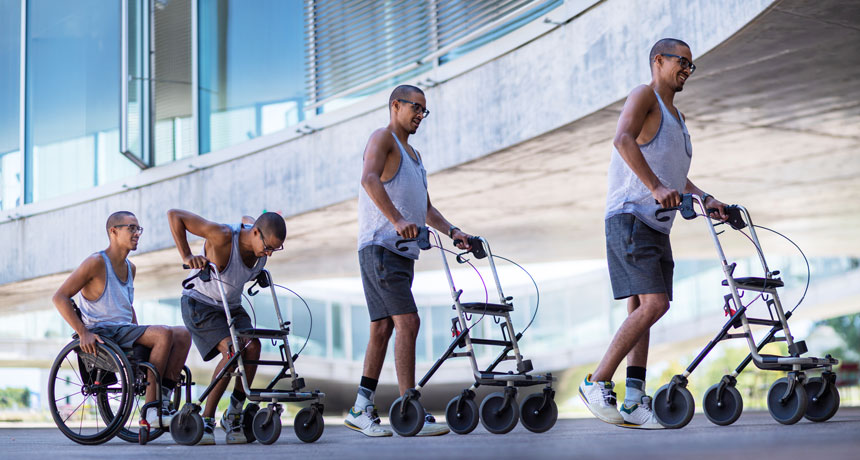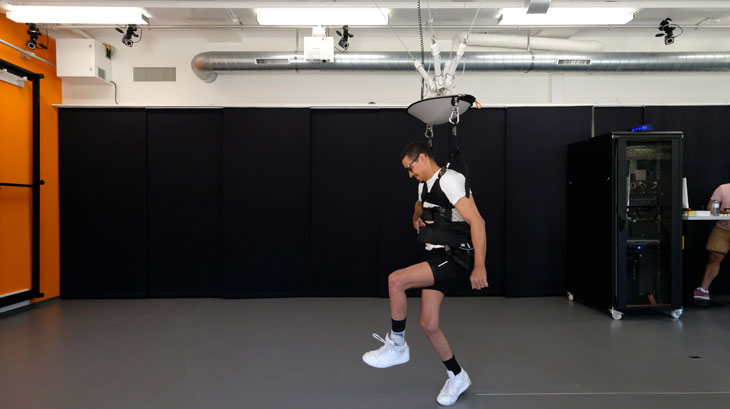Stimulating the spinal cord helps 3 more paralyzed people walk
Independent groups of scientists have now made similar progress using the therapy

RECOVERY IN ACTION David Mzee, 28, was paralyzed in 2010. After five months of rehabilitation involving targeted electrical stimulation to his spinal cord, Mzee (seen above in this composite image) can now walk for an hour at a time with some help supporting his weight.
© Jamani Caillet/EPFL
- More than 2 years ago
Paralysis is becoming less permanent — at least for some.
There’s now more evidence that stimulating the spinal cord can restore voluntary movement in paralyzed patients who haven’t recovered after other treatments. After five months of training coupled with targeted stimulation of nerve cells in the spinal cord, three people who had a severe spinal cord injury regained the ability to walk with varying degrees of support, researchers report online October 31 in Nature.
Stimulating nerve cells, or neurons, in the spinal cord with electric jolts works by amplifying signals coming from the lower extremities, helping the brain and legs of paralyzed people to communicate better. But after undergoing the therapy, two of the patients were even able to walk on crutches without the electrical stimulation. That suggests that the treatment may have helped strengthen neural connections between the brain and spinal cord that were not functional or barely working post-injury.
Such a level of recovery is “extremely exciting,” says Chet Moritz, a neuroscientist at the University of Washington in Seattle who wasn’t involved in the work.
All three patients were paralyzed from an injury at least four years earlier, but hadn’t regained movement after extensive rehabilitation, despite having some neural connections remaining at the injury site. The finding comes on the heels of two other major studies published in September, one in the New England Journal of Medicine and one in Nature Medicine, showing similar gains in patients who had a form of paralysis where those connections were totally nonfunctional (SN: 10/27/18, p. 15).
“Extending these findings into these two different populations is really important,” says Susan Harkema, a neuroscientist at the University of Louisville in Kentucky. In patients with different kinds of chronic spinal cord injuries, “we’ve showed with training and stimulation, people … have the capacity to recover,” says Harkema, who coauthored the earlier study in the New England Journal of Medicine.
The accomplishment was a technological challenge, says Grégoire Courtine, a neuroengineer at the Swiss Federal Institute of Technology in Lausanne and a coauthor of the new study. Like Harkema’s team, Courtine and colleagues implanted a pulse-generating machine into their patients. The matchbox-sized device was originally designed as a pain management therapy.
Certain patterns of spinal cord stimulation work better for triggering certain movements, like lifting a leg versus setting it down, previous research has shown. So rather than have the stimulator run constantly, as previous studies have done, Courtine’s team designed a wireless system to control the stimulator so that it delivered targeted pulses of electricity to specific neurons at precise times, coordinated with desired muscle movements.
The more targeted stimulation “takes [the therapy] to the next level,” Moritz says.
Constant stimulation can also interfere with patients’ abilities to sense their limbs in space, Courtine’s team reports in a separate study published October 31 in Nature Neuroscience. Feeling where limbs are in space is important for complex coordinated movements like walking, which requires many muscle groups to work together, Courtine says. The selective stimulation was better at improving movement in the patients the researchers tested, amplifying conversations between the extremities and the brain without drowning out sensation.
Patients receiving the pulses had to learn how to coordinate their own movements with the stimulation. At first, people had assistance from a contraption that supported their trunk and helped them remain upright. Within a week of starting the treatment, all three patients could walk while receiving spinal cord stimulation. After five months, two patients had progressed to walking hands-free with just 35 percent of their body weight supported in the harness. A third, who had more severe injuries, needed more assistance.

Patients even regained the ability to make movements without the electrical stimulation running. Two patients could move from sitting to standing and walk short distances with crutches. The third patient could voluntarily move his legs without stimulation.
That result is why Courtine and his colleagues hope to next test the technology in people who have been injured more recently. By starting rehab sooner, before muscles and nerves have atrophied as they usually do post-paralysis, patients might make even greater strides.
Editor’s note: This story was updated on November 7, 2018, to correct the credit for the top image. The image had been misattributed in a media release.






